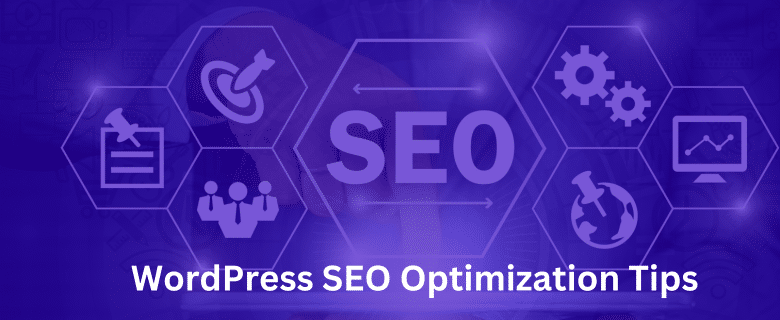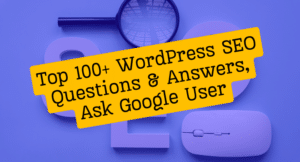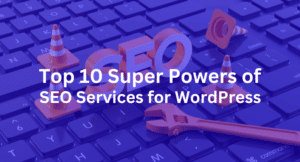Table of Contents
Introduction
In the realm of website development, WordPress reigns supreme as the most popular Content Management System (CMS). However, merely having a WordPress website isn’t enough to attract organic traffic. To maximize visibility and drive engagement, it’s essential to implement effective SEO strategies tailored specifically for WordPress sites. Let’s start the WordPress SEO optimization tips
WordPress SEO Optimization Tips:

Here are 13 essential WordPress SEO optimization tips to boost your website’s visibility and rankings: optimize website speed, use SEO-friendly URLs, implement responsive design, target keywords strategically, improve user experience, utilize heading tags, optimize images, leverage internal linking, ensure mobile-friendliness, implement schema markup, focus on high-quality content, use SEO plugins, update your site regularly, and monitor performance.
1. Optimize Your Website Speed
Website speed is a critical factor in user experience and SEO ranking. Ensure your WordPress site loads quickly by optimizing images, leveraging caching plugins, and utilizing a content delivery network (CDN).

Importance of Website Speed
Having a fast website speed is crucial for user experience and SEO. Here’s why:
- User Experience: Users expect fast-loading websites. A slow site can lead to higher bounce rates and decreased user engagement.
- SEO Impact: Website speed is a Google ranking factor. Faster sites tend to rank higher in search results, leading to more organic traffic.
- Conversion Rates: Improved speed can boost conversions. Studies show that even small delays can impact conversion rates negatively.
Some web tools can help you check your website speed, Like Google PageSpeed, Pingdom, GTmetrix
Optimizing Your Website Speed
Follow these steps to optimize your website speed:
- Choose a Good Hosting Provider: Select a reliable hosting provider with good server performance.
- Optimize Images: Compress images and use appropriate formats (JPEG, PNG) to reduce file size.
- Enable Browser Caching: Leverage browser caching to reduce load times for returning visitors.
- Minimize HTTP Requests: Reduce the number of elements on your page to minimize HTTP requests.
- Use a Content Delivery Network (CDN): Implement a CDN to distribute content across servers geographically closer to users.
- Enable GZIP Compression: Compress your website files to reduce bandwidth usage and speed up loading times.
- Minify CSS, JavaScript, and HTML: Remove unnecessary spaces, comments, and formatting to reduce file sizes.
- Reduce Server Response Time: Optimize server performance to improve response times.
By implementing these optimization techniques, you can significantly enhance your website’s speed and overall performance.
2. Implement SEO-Friendly URLs
Craft concise and descriptive URLs that include relevant keywords. Avoid generic URLs like “domain.com/page123” and opt for URLs that provide insight into the page’s content.

Importance of SEO-Friendly URLs
SEO-friendly URLs play a critical role in enhancing the visibility and ranking of your website in search engines. Here’s why they are important and how to implement them effectively:
- Improved User Experience: SEO-friendly URLs are easy to read, understand, and remember for users, leading to a better overall user experience.
- Enhanced Crawlability: Search engine bots can easily crawl and index pages with descriptive URLs, which contributes to better search engine rankings.
- Keyword Optimization: Including relevant keywords in the URL helps search engines understand the content of the page, improving its relevance for specific search queries.
How to Implement SEO-Friendly URLs
Implementing SEO-friendly URLs involves following these key practices:
- Use Descriptive Keywords: Incorporate relevant keywords that accurately describe the content of the page.
- Keep it Short and Simple: Avoid long and complex URLs. Aim for concise URLs that convey the page’s topic clearly.
- Use Hyphens to Separate Words: Use hyphens (-) to separate words in the URL instead of underscores or spaces.
- Avoid Stop Words: Remove unnecessary words like “and,” “the,” or “of” from the URL to keep it focused and concise.
- Maintain Consistency: Use consistent URL structures across your website to create a uniform experience for users and search engines.
Implementing these practices will help optimize your URLs for better search engine visibility and user engagement.
3. Use Responsive Design
With the majority of internet users accessing websites via mobile devices, responsive design is paramount. Ensure your WordPress theme is mobile-friendly to enhance user experience and SEO ranking.

Why Responsive Design is Essential
Responsive design is crucial for websites today due to the widespread use of mobile devices. Here’s why you need it and how to implement it effectively:
- Improved User Experience: Responsive design ensures that your website looks great and functions well on all devices, providing a seamless user experience across smartphones, tablets, and desktops.
- Mobile-Friendly: With more users accessing websites on mobile devices, having a responsive design is essential to cater to this audience and maintain engagement.
- SEO Benefits: Google prioritizes mobile-friendly websites in search results, making responsive design important for SEO performance and visibility.
- Cost-Effectiveness: Instead of developing separate websites for different devices, responsive design streamlines development and maintenance efforts, reducing costs.
- Flexibility: Responsive design adapts to different screen sizes and orientations, ensuring your website looks polished and professional on any device.
How to Implement Responsive Design
To achieve an effective responsive design for your website:
- Use Media Queries: Employ CSS media queries to apply styles based on the device’s characteristics, such as screen width.
- Flexible Grid Layouts: Implement flexible grid layouts that adjust based on screen size, allowing content to reflow smoothly.
- Responsive Images: Use CSS techniques like max-width: 100% to ensure images scale appropriately for different devices.
- Test Across Devices: Regularly test your website on various devices to ensure consistent performance and usability.
- Consider Mobile-First Approach: Start with mobile design considerations and progressively enhance the layout for larger screens.
By adopting responsive design principles, you can enhance user experience, boost SEO performance, and cater to the diverse needs of your audience across devices.
4. Optimize Content with Targeted Keywords
Identify relevant keywords related to your niche and incorporate them strategically into your content. Use tools like Google Keyword Planner or SEMrush to identify high-ranking keywords.

Why Optimize Content with Targeted Keywords?
Optimizing content with targeted keywords is essential for improving search engine visibility and attracting relevant traffic to your website. Here’s why it’s crucial:
- Enhanced Search Engine Rankings: By strategically incorporating targeted keywords into your content, you increase the likelihood of ranking higher on search engine results pages (SERPs) for those specific terms. This helps potential customers discover your website more easily.
- Relevance and User Intent: Using targeted keywords ensures that your content aligns with what users are searching for. This enhances the relevance of your content and improves user experience, leading to higher engagement and conversions.
- Increased Organic Traffic: When your content ranks higher for targeted keywords, it attracts more organic traffic from users actively seeking information related to those keywords. This traffic is often more qualified and likely to convert into leads or customers.
- Competitive Edge: Effective keyword optimization helps you stay ahead of competitors by targeting specific niches and capturing relevant search traffic before others in your industry.
How to Optimize Content with Targeted Keywords:
- Keyword Research: Identify relevant keywords that align with your content and audience.
- Strategic Placement: Integrate keywords naturally into headings, subheadings, body content, meta tags, and image alt text.
- Avoid Keyword Stuffing: Maintain a natural flow of content without overusing keywords, which can hurt readability and SEO.
- Create High-Quality Content: Focus on creating valuable, informative, and engaging content that naturally incorporates keywords.
- Monitor Performance: Regularly analyze keyword performance and adjust your optimization strategy based on insights from analytics tools like Google Analytics or SEMrush.
Optimizing content with targeted keywords is a foundational aspect of SEO that can significantly impact your website’s visibility and success in organic search.
5. Improve User Experience
User experience (UX) plays a crucial role in SEO. Design intuitive navigation, utilize clear calls-to-action, and prioritize readability to keep visitors engaged and reduce bounce rates.

Why Improve User Experience?
User experience (UX) plays a pivotal role in determining the success of a website. Enhancing UX not only improves visitor satisfaction but also contributes to better SEO performance and increased conversions.
- Boosts SEO Ranking:
- Search engines prioritize user-friendly websites in their rankings.
- Factors like page load speed, mobile responsiveness, and intuitive navigation directly impact SEO.
- Enhances Engagement:
- A seamless UX encourages visitors to stay longer on your site.
- Engaged users are more likely to explore further and convert.
- Reduces Bounce Rate:
- A positive UX reduces bounce rates, indicating that visitors find value in your content.
- Lower bounce rates signal to search engines that your site is relevant and engaging.
- Improves Conversions:
- Intuitive UX design guides users through the conversion funnel.
- Clear calls-to-action and streamlined checkout processes enhance conversion rates.
- Builds Brand Reputation:
- Exceptional UX builds trust and credibility with your audience.
- Positive experiences lead to repeat visits and recommendations.
How to Improve User Experience
- Optimize Page Speed:
- Compress images, leverage browser caching, and minimize HTTP requests.
- Implement Mobile Responsiveness:
- Ensure seamless usability across all devices, including smartphones and tablets.
- Simplify Navigation:
- Use clear menus and logical site structures to help users find information effortlessly.
- Prioritize Content Readability:
- Use legible fonts, appropriate font sizes, and sufficient white space.
- Enhance Visual Design:
- Use engaging visuals, consistent branding, and intuitive layouts.
- Test and Iterate:
- Conduct user testing and gather feedback to identify pain points and make iterative improvements.
By prioritizing user experience and implementing these strategies, businesses can create websites that not only rank well in search engines but also provide meaningful interactions that drive conversions and foster customer loyalty.
6. Utilize Heading Tags
Organize your content using H1, H2, and H3 heading tags to structure your content logically. Heading tags not only enhance readability but also provide search engines with context about your content.

Why Utilize Heading Tags?
Heading tags play a crucial role in optimizing content for search engines and enhancing user experience. Here’s why they are essential and how to use them effectively:
1. Organize Content Hierarchy
- Heading tags (H1 to H6) establish a clear hierarchy within your content, making it easier for search engines to understand the structure.
- Properly structured content improves readability and helps users navigate through your webpage.
2. SEO Benefits
- Search engines use heading tags to determine the main topics of a webpage.
- Including relevant keywords in heading tags can boost your content’s visibility in search engine results.
3. Enhanced User Experience
- Clear headings break up content into digestible sections, improving user comprehension.
- Users can quickly scan the page to find information relevant to their needs.
6.4. Accessibility
- Screen readers and other assistive technologies use heading tags to help visually impaired users navigate web content.
- Using semantic heading tags ensures accessibility standards are met.
How to Utilize Heading Tags Effectively:
1. Use H1 for Main Title
- Include your primary keyword in the H1 tag to clearly indicate the topic of the page.
2. Hierarchy with H2 and Subsequent Tags
- Use H2 tags for main sections and H3, H4, etc., for subsections.
- Maintain a logical hierarchy to organize content.
3. Avoid Skipping Heading Levels
- Follow a sequential order (H1, H2, H3…) without skipping levels to maintain content structure.
4. Focus on Relevance and Clarity
- Ensure each heading accurately reflects the content of the section it precedes.
- Write concise, descriptive headings that entice users to engage with your content.
By leveraging heading tags effectively, you can enhance your website’s SEO performance, improve user engagement, and create a more accessible web experience for all users.
7. Optimize Images for SEO
Optimize image alt text, file names, and sizes to improve SEO. Use descriptive alt text that includes relevant keywords to enhance image search visibility.

Importance of Optimizing Images for SEO
In the digital age, optimizing images for search engines is a critical aspect of any comprehensive SEO strategy. Here’s why it matters and how you can do it effectively:
1. Enhances User Experience
Optimized images improve user experience by reducing page load times, which can significantly impact bounce rates and visitor retention.
2. Boosts Organic Visibility
Properly optimized images can appear in Google Image Search results, expanding your website’s reach and attracting additional organic traffic.
3. Improves Accessibility
Alt text and descriptive file names make images accessible to visually impaired users who rely on screen readers, enhancing overall inclusivity.
4. Reduces Server Load
Compressed and properly sized images reduce server load, leading to faster website performance and improved crawlability.
How to Optimize Images for SEO
- Use Descriptive Filenames: Rename image files with relevant keywords before uploading.
- Add Alt Text: Include descriptive alt text that accurately describes the image’s content and purpose.
- Optimize Image Size: Compress images to reduce file size without compromising quality.
- Choose the Right Format: Use appropriate image formats (JPEG, PNG, WebP) based on the image’s content and purpose.
- Implement Lazy Loading: Load images only when they come into view, improving page speed.
Optimizing images for SEO not only enhances your website’s visibility but also contributes to a better overall user experience. By following these tips, you can leverage images to drive organic traffic and improve search engine rankings.
8. Internal Linking Strategies
Implement internal linking to establish a hierarchy of information on your website. Link relevant pages within your content to improve navigation and distribute link equity.

Why Internal Linking Matters
Internal linking is a critical aspect of SEO that enhances user experience and search engine visibility. Here’s why it’s essential:
- Enhances Site Structure: Internal links establish a logical hierarchy and structure within your website, making it easier for users and search engines to navigate.
- Boosts SEO Performance: By strategically linking related pages, you can distribute link equity across your website, improving the overall authority and ranking potential.
- Improves User Engagement: Internal links guide users to relevant content, encouraging them to explore more pages and spend more time on your site.
- Indexes Pages Faster: Search engines use internal links to discover and crawl new pages more efficiently, ensuring timely indexing of your content.
How to Implement Effective Internal Linking Strategies
Follow these tips to maximize the impact of your internal linking efforts:
- Use Descriptive Anchor Text: Opt for descriptive anchor text that accurately reflects the linked page’s content.
- Link Contextually: Integrate internal links naturally within your content, focusing on relevance and user intent.
- Prioritize Top Pages: Link from high-authority pages to important target pages to pass link equity and boost their rankings.
- Create Topic Clusters: Organize related content into topic clusters and interlink them strategically to reinforce topical relevance.
- Regularly Audit Links: Conduct periodic audits to identify broken links or opportunities for additional internal linking.
- Avoid Over-Optimization: Maintain a balanced approach to internal linking and avoid excessive linking that can appear spammy.
Implementing a robust internal linking strategy can significantly enhance your website’s SEO performance and user engagement, leading to improved rankings and visibility.
9. Ensure Mobile-Friendliness
Google prioritizes mobile-friendly websites in search results. Use Google’s Mobile-Friendly Test to ensure your WordPress site is optimized for mobile devices.

Why Mobile-Friendliness Matters
In today’s digital age, ensuring that your website is mobile-friendly is imperative for several reasons:
- User Experience Enhancement: Mobile users expect seamless browsing experiences. A mobile-friendly website provides easy navigation, readability, and faster loading times on smartphones and tablets.
- SEO Benefits: Google prioritizes mobile-friendly websites in search rankings. By optimizing for mobile, you enhance your website’s visibility and reach.
- Audience Reach: A significant portion of web traffic comes from mobile devices. Ignoring mobile optimization means potentially losing out on valuable visitors and conversions.
- Reduced Bounce Rates: Mobile-friendly websites tend to have lower bounce rates, as users can easily access and engage with content on their devices.
- Competitive Edge: In a competitive market, a mobile-friendly website sets you apart from competitors who may not have optimized their sites for mobile.
How to Ensure Mobile-Friendliness
Achieving mobile-friendliness involves specific strategies and best practices:
- Responsive Design: Use responsive web design techniques to ensure your website adapts to various screen sizes and resolutions.
- Mobile-Friendly Content: Optimize content for mobile consumption by using shorter paragraphs, concise headlines, and high-quality images that load quickly.
- Page Speed Optimization: Improve loading speeds by optimizing images, leveraging browser caching, and minimizing unnecessary code.
- Mobile-Friendly Navigation: Simplify navigation for mobile users with clear menus, intuitive buttons, and easy access to important sections.
- Test Across Devices: Regularly test your website’s mobile performance across different devices and browsers to identify and address any issues.
By prioritizing mobile-friendliness, you enhance user experience, boost SEO rankings, and ultimately drive more traffic and conversions to your website.
10. Schema Markup for Rich Snippets
Implement schema markup to enhance your website’s appearance in search engine results pages (SERPs). Rich snippets, such as star ratings and FAQ sections, can increase click-through rates.

Why Schema Markup for Rich Snippets?
In today’s competitive digital landscape, leveraging schema markup for rich snippets has become imperative for businesses looking to enhance their online visibility and click-through rates. Here’s why you need schema markup and how to implement it effectively:
Enhance Search Visibility
- Schema markup helps search engines better understand your content, leading to enhanced visibility in search results.
- Rich snippets provide more information to users directly in search results, increasing click-through rates.
Improve Click-Through Rates
- Rich snippets attract user attention with additional details like star ratings, prices, and availability, enticing more clicks.
- Users are more likely to click on results with rich snippets due to the enhanced information provided.
Boost SEO Performance
- Implementing schema markup can lead to improved organic rankings by providing structured data that search engines can easily interpret.
- Rich snippets can differentiate your content from competitors and capture more organic traffic.
Provide Relevant Information
- Schema markup allows you to highlight key information such as product details, reviews, events, and FAQs, making your content more relevant to user queries.
- Rich snippets increase user engagement by providing instant answers to specific questions.
How to Implement Schema Markup
- Identify Suitable Schema Types: Choose relevant schema types (e.g., Product, Recipe, Article) based on your content.
- Add Schema Markup to HTML: Incorporate schema markup directly into your HTML using structured data formats like JSON-LD or microdata.
- Validate Markup: Use Google’s Structured Data Testing Tool to validate and ensure correct implementation.
- Monitor Performance: Regularly monitor search appearance and click-through rates to assess the impact of schema markup.
- Stay Updated: Keep abreast of schema.org updates and best practices to optimize schema markup for evolving search algorithms.
Implementing schema markup for rich snippets can significantly enhance your website’s visibility, user engagement, and overall SEO performance. Start leveraging schema markup today to unlock the full potential of your online content.
11. Focus on High-Quality Content
Produce valuable, well-researched, and original content that addresses your audience’s needs. High-quality content attracts backlinks and boosts organic traffic.

Why Focus on High-Quality Content?
In the digital age, high-quality content is the cornerstone of successful online marketing and SEO strategies. Here’s why prioritizing quality content matters:
- Boosts Search Engine Rankings:
- High-quality content is more likely to rank higher in search engine results pages (SERPs) because it provides value to users and aligns with search intent.
- Enhances User Engagement:
- Quality content captivates and engages your audience, leading to longer dwell times, reduced bounce rates, and increased conversions.
- Builds Trust and Authority:
- Consistently publishing valuable and informative content helps establish your brand as an authority in your industry, fostering trust with your audience.
- Drives Organic Traffic:
- Well-optimized and valuable content attracts organic traffic from search engines, reducing reliance on paid advertising.
How to Focus on High-Quality Content
Achieving high-quality content requires strategic planning and execution:
- Understand Your Audience:
- Conduct research to identify your target audience’s needs, preferences, and pain points to tailor your content accordingly.
- Create Original and Valuable Content:
- Offer unique insights, actionable tips, and comprehensive information that add genuine value to your audience.
- Optimize for SEO:
- Use relevant keywords naturally, optimize meta tags, and structure content for readability and SEO best practices.
- Regularly Update and Refresh Content:
- Keep your content up-to-date with industry trends and insights to maintain relevance and authority.
- Utilize Visuals and Multimedia:
- Incorporate images, infographics, videos, and interactive elements to enhance engagement and convey information effectively.
By focusing on high-quality content, businesses can drive organic traffic, foster audience engagement, and establish credibility in the digital landscape.
Conclusion:
Implementing these top 11 WordPress SEO optimization tips will undoubtedly enhance your website’s visibility and organic traffic. By focusing on technical aspects, content quality, and user experience, you can position your WordPress site for success in search engine rankings.
FAQs
What is the best WordPress SEO plugin?
Both Yoast SEO and Rank Math are highly recommended for WordPress SEO.
How often should I update my WordPress site?
Aim to update your WordPress site, themes, and plugins at least once a month to ensure optimal performance and security.
Why is mobile-friendliness important for SEO?
Google prioritizes mobile-friendly websites to enhance user experience for mobile users.
What is schema markup?
Schema markup is structured data that provides additional context to search engines about your website’s content.
How do I optimize images for SEO?
Optimize images by using descriptive alt text, compressing file sizes, and naming files with relevant keywords.



